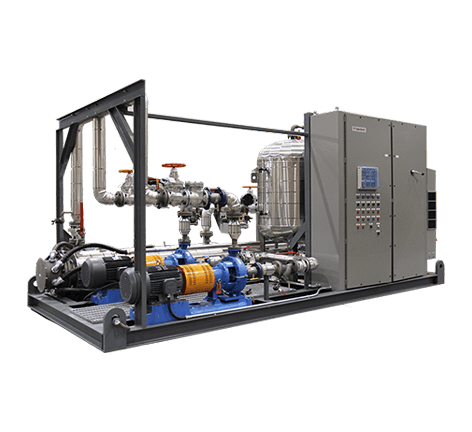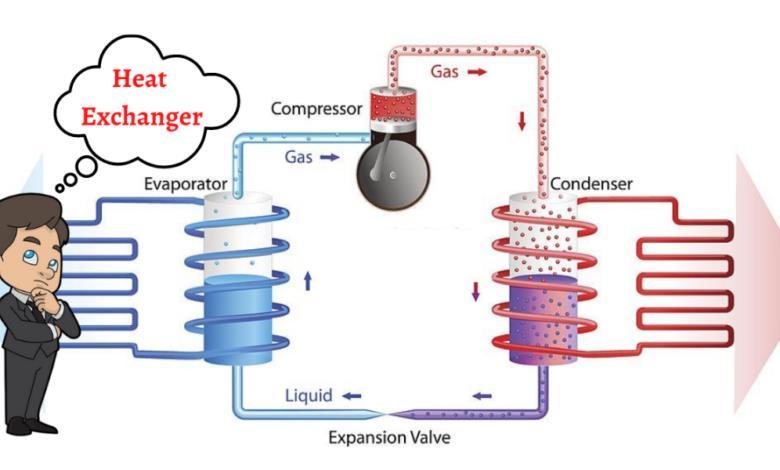A Deep Dive into Advanced CFD Modeling in DVS Heat Transfer Systems
Wiki Article
A Comprehensive Guide to Selecting the Right Heat Transfer Equipments for Your Requirements
Selecting the ideal Heat transfer system is essential for functional performance. Various systems provide to different demands, influenced by variables such as temperature level array and liquid type. Recognizing the principles behind Heat transfer, such as conduction, convection, and radiation, is vital. In addition, evaluating power sources and maintenance techniques can influence lasting efficiency. A closer evaluation of these considerations exposes how to customize a system to specific demands. What should one prioritize in this complex decision-making process?Comprehending Heat Transfer: Key Ideas and Concepts
Heat transfer may appear like a straightforward concept, it incorporates a range of concepts that are essential for reliable system layout - DVS Heat Transfer Systems. Understanding these concepts is essential for designers and developers that aim to maximize thermal performance in different applications. Transmission, for example, entails the transfer of Heat through strong materials, while convection refers to the movement of Heat within fluids. Radiation, an additional crucial principle, describes how Heat can be moved through electromagnetic waves. Each of these mechanisms plays a vital role in determining just how energy relocates within a system. By extensively understanding these principles, experts can make enlightened decisions, making certain that Heat transfer systems run successfully and satisfy the particular needs of their applications
Kinds of Heat Transfer Systems: A Summary
Recognizing the principles of Heat transfer lays the foundation for exploring the different types of Heat transfer systems readily available. Heat transfer systems can be categorized largely right into three kinds: transmission, convection, and radiation. Transmission involves Heat transfer via strong materials, depending on straight get in touch with between fragments. Convection, on the other hand, happens in fluids (fluids and gases) where the movement of the liquid itself helps with Heat transfer. Radiation includes the transfer of Heat with electromagnetic waves and does not require a medium, enabling it to take place in a vacuum cleaner. Each type of system has unique characteristics and applications, making it important for people and organizations to very carefully examine their details needs when picking the most suitable Heat transfer service.Applications of Heat Transfer Equipments in Various Industries
Heat transfer systems play a vital role across numerous sectors, affecting performance and product top quality. In commercial production procedures, they help with exact temperature control, while in food and beverage processing, they assure safety and security and preservation. Furthermore, cooling and heating and environment control systems depend greatly on reliable Heat transfer to maintain comfortable settings.Industrial Production Processes

Various industrial manufacturing processes rely heavily on effective Heat transfer systems to maximize efficiency and boost item top quality. In sectors such as metalworking, Heat exchangers play a vital duty in keeping excellent temperature levels throughout welding, spreading, and forging. These systems ensure uniform Heat distribution, which is crucial for accomplishing preferred material properties. In a similar way, in the chemical manufacturing industry, Heat transfer systems assist in precise temperature control throughout reactions, affecting yield and security. In fabric manufacturing, effective Heat monitoring is crucial for dyeing and finishing procedures, affecting color consistency and textile high quality. By selecting appropriate Heat transfer technologies, producers can boost energy efficiency and reduce operational prices, eventually resulting in a more competitive and lasting production environment.
Food and Beverage Handling
Effective Heat transfer systems are just as crucial in the food and beverage processing market, where preserving ideal temperatures is important for food safety and top quality. These systems play an important role in procedures such as sterilization, pasteurization, and food preparation, making certain that products are safe for usage and keep their dietary value. Heat exchangers, for example, effectively move Heat in between liquids, enhancing power usage while reducing temperature fluctuations. Furthermore, refrigeration systems are basic for preserving disposable items and extending service life. The option of Heat transfer modern technology directly impacts functional effectiveness and item honesty, making it vital for food and drink suppliers to select the proper systems customized to their details handling demands. This careful choice eventually adds to consumer satisfaction and food safety.
A/c and Climate Control
While lots of sectors rely upon Heat transfer systems for effectiveness, HVAC (Heating, Ventilation, and Cooling) plays a necessary duty in maintaining indoor environment control across different settings. These systems make use of Heat transfer concepts to manage temperature, air, and humidity quality, making certain convenience and safety in property, business, and commercial environments. Appropriately created HVAC systems improve energy performance, reduce operational prices, and decrease environmental effect. In business structures, as an example, effective climate control adds to worker productivity and consumer fulfillment. In commercial applications, cooling and heating systems help keep perfect conditions for devices operation and product preservation. Picking the best Heat transfer system is important for meeting particular climate control needs and attaining total system efficiency.Reviewing Power Sources for Heat Transfer Systems
In assessing energy sources for Heat transfer systems, a comparison of eco-friendly power choices and fossil fuel considerations is necessary. Eco-friendly resources, such as solar and wind, deal sustainable alternatives that can reduce environmental impact. Conversely, nonrenewable fuel sources continue to be common because of their recognized facilities and energy thickness, triggering a careful analysis of both alternatives.Renewable Power Options

Fossil Fuel Factors To Consider
Reviewing nonrenewable fuel source factors to consider is necessary for the effectiveness and sustainability of Heat transfer systems. Fossil fuels, such as natural gas, oil, and coal, are typical power resources that provide substantial Heat output, making them preferred selections for commercial and property applications. Nevertheless, their ecological effect, including greenhouse gas exhausts and resource exhaustion, increases issues. When picking a warm transfer system, it is important to evaluate the schedule, cost, and regulatory factors connected with these fuels. Additionally, the efficiency of fossil gas systems must be considered, as higher effectiveness can mitigate some ecological disadvantages. Ultimately, a well balanced strategy considering performance and sustainability can assist decision-makers towards one of the most proper Heat transfer option for their certain requirements.Elements to Consider When Selecting a Warmth Transfer System
Selecting an appropriate Heat transfer system needs cautious factor to consider of different variables that can considerably influence efficiency and efficiency. One crucial factor is the operating temperature level range, which dictates the products and style appropriate for the application. In addition, the kind of liquid made use of in the system-- whether gas or liquid-- impacts Heat transfer performance and compatibility. The system's size and ability have to straighten with the certain demands of the operation to avoid inadequacies. Power source availability is likewise vital, affecting operating expenses and sustainability. Furthermore, the setup environment, including room restrictions and accessibility for maintenance, plays a substantial duty in system option. Regulative compliance and safety standards should be considered to assure the system meets all legal demands.Maintenance and Efficiency Optimization for Heat Transfer Solutions
Preserving Heat transfer systems is crucial for making certain optimal effectiveness and longevity. Regular upkeep activities, such as cleansing Heat exchangers and examining insulation, help protect against effectiveness losses due to fouling and thermal linking. Additionally, keeping track of system parameters, consisting of pressure and temperature level, enables very early detection of abnormalities, lessening downtime and expensive repair services. Executing a preventive upkeep timetable can enhance efficiency and extend the life-span of parts. Updating to innovative control systems can enhance operational performance by adjusting to varying lots and problems. By focusing on upkeep and efficiency optimization, operators can accomplish lowered energy intake, reduced operational expenses, and boosted total system dependability, inevitably leading to much better source application and a much more lasting procedure.Future Fads in Heat Transfer Technologies
As industries progressively focus on sustainability and energy efficiency, future fads in Heat transfer technologies are readied to go through substantial transformations. Developments such as sophisticated materials, including carbon nanotubes and nanofluids, assure enhanced thermal conductivity and performance. In addition, the integration of renewable energy sources right into Heat transfer systems is getting momentum, promoting environment-friendly services. Smart innovations, including IoT sensors, are expected to transform monitoring and control, enabling real-time data analysis for optimized efficiency. In addition, the growth of portable and modular systems will certainly facilitate easier installation and upkeep, dealing with diverse applications. These advancements show a change towards more sustainable, reliable, and versatile Heat transfer remedies, straightening with international power goals and ecological requirements.
Frequently Asked Inquiries
What Are the Ecological Effects of Heat Transfer Solutions?
The environmental influences of Heat transfer systems can consist of greenhouse gas emissions, power usage, and potential thermal air pollution. Furthermore, improper disposal of inefficiencies and products can contribute to source depletion and ecosystem disturbance.Exactly how Do I Compute the Cost-Effectiveness of a Warm Transfer System?
To compute the cost-effectiveness of a heat transfer system, one should evaluate preliminary expenses, operational costs, maintenance demands, and power efficiency, contrasting these elements versus the expected life-span and performance of the system.Can Heat Transfer Equipment Be Utilized in Residential Settings?
Heat transfer systems can certainly be utilized in household settings. They supply efficient home heating and cooling services, making homes extra comfortable while potentially decreasing power prices. Their adaptability enables various applications in domestic settings.What Security Rules Apply to Heat Transfer Systems?
Security regulations for Heat transfer systems typically consist of guidelines on procedure, maintenance, and installment. Conformity with neighborhood building regulations, manufacturer specifications, and market requirements is vital to guarantee safe and efficient system performance in numerous applications.Just How Do Various Products Affect Heat Transfer Effectiveness?

Transmission, for instance, entails the transfer of Heat with solid materials, while convection refers to the motion of Heat within fluids. Recognizing the principles of Heat transfer lays the foundation for exploring the numerous kinds of Heat transfer systems offered. Heat exchangers, for circumstances, efficiently transfer DVS Heat Transfer Systems Heat in between liquids, optimizing energy use while decreasing temperature changes. In examining power resources for Heat transfer systems, a comparison of sustainable energy alternatives and fossil gas considerations is vital. Steels, such as copper and light weight aluminum, conduct Heat effectively, whereas insulators like rubber and glass slow down Heat flow.
Report this wiki page